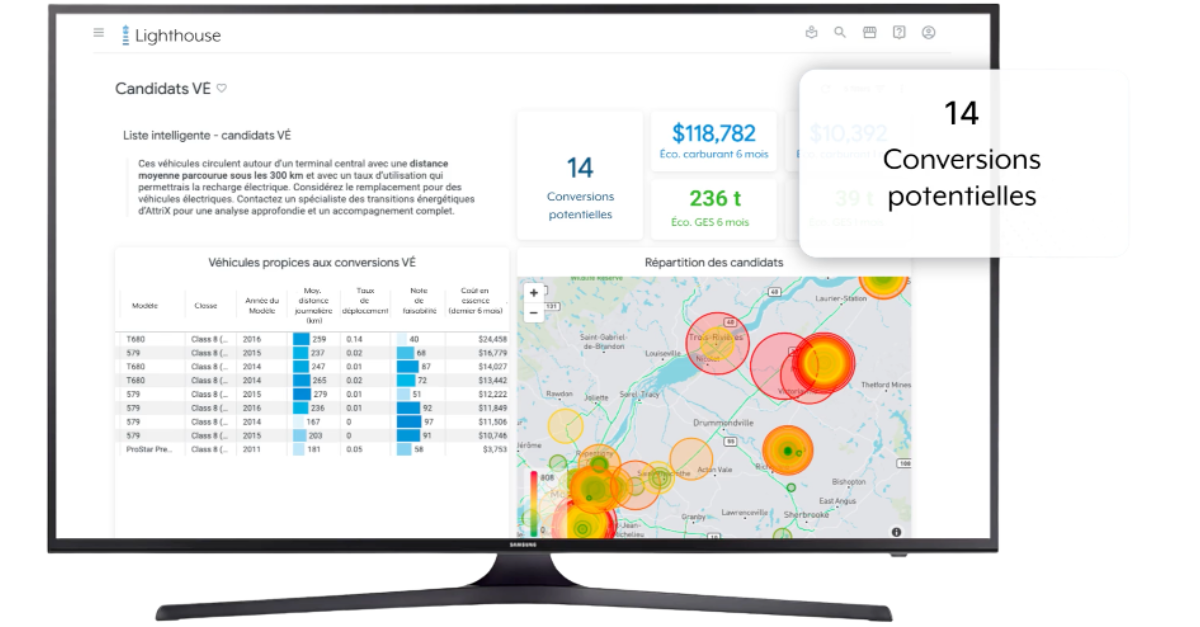Commercial Fleet Management: Strategies, Tools & Tips
Commercial fleet management plays a vital role in keeping businesses running smoothly, especially in industries like transportation, logistics, and...
Keep an eye on the road
Simplify your driver's routine
For efficient decision making
Ensure the compliance of your fleet
Simplify the daily life of your drivers
Maximize the value of your data
Unparalleled monitoring of your assets
The friendly competition that pays off
Planning powered by data
Exceed your customers' expectations
Provide better service to your users
Maximize the satisfaction of your citizens
Simplify your daily life on the construction site
Facilitate the electrification of your fleet
Our experts meet your needs
Easily meet the standards
Improve the safety of your drivers
Protect your data and your fleet
4 min read
AttriX
Feb 22, 2024 2:32:15 PM

Business Intelligence (BI) has wholly transformed fleet management. This shift towards a more data-centric approach has enhanced operational efficiency and strategic decision-making while moving away from traditional practices. Incorporating BI tools into fleet management provides a comprehensive overview of fleet operations, enabling managers to optimize routes, reduce costs, and improve overall performance. This integration simplifies processes and opens up new avenues for growth and innovation in fleet management strategies. Business Intelligence is more than just a buzzword in fleet management; it is a transformative approach that uses data analysis to drive smarter decisions. Companies can uncover insights that lead to significant cost savings and efficiency improvements by analyzing travel, maintenance, and driver behaviour patterns.
This post will explore how BI reshapes fleet management, highlighting key technologies, strategies, and real-world applications that illustrate its transformative impact.
Initially, fleet management focused primarily on maintaining vehicles and scheduling routes. However, with the introduction of BI, it has evolved into a more nuanced field that leverages data for strategic planning and operational improvements. This progression has been fueled by technological advancements, which have made it easier to collect and analyze large volumes of data. Today's fleet managers have access to a wealth of information that can be used to optimize performance and reduce costs.
The integration of business intelligence into fleet management represents a significant paradigm shift. It allows for a more proactive approach, where decisions are based on comprehensive data analysis rather than intuition or experience alone. This evolution has improved asset utilization, customer service, and operational transparency. By harnessing the power of data, fleet managers can anticipate challenges, identify opportunities, and implement solutions that drive tangible business outcomes.
A robust BI system for fleet management relies heavily on its ability to collect and manage large amounts of data efficiently. The data that needs to be collected includes information from vehicles such as location, fuel usage, and maintenance records, as well as external data sources like traffic patterns and weather conditions. This data's aggregation and proper organization are crucial for the subsequent analysis and reporting stages.
The analysis is the core of BI, which converts the raw data into actionable insights. Fleet managers can identify patterns and trends that inform strategic decisions through various analytical methods like predictive analytics and machine learning. For example, analyzing fuel consumption patterns can optimize routes and reduce fuel costs. Similarly, maintenance data can be used to predict vehicle breakdowns, thereby minimizing downtime.
To successfully incorporate Business Intelligence into fleet management, it is essential to have a well-planned strategy that aligns with the overall business objectives. The first step of this process is to comprehensively evaluate current fleet management practices to identify areas that can benefit from BI. This might include optimizing routes, scheduling maintenance, or monitoring driver performance.
Once potential areas for BI integration are identified, the next step is to implement the appropriate BI tools and technologies. This involves selecting software that seamlessly integrates with existing systems and offers the functionalities required to meet specific business needs. It is also crucial to ensure that employees are adequately trained to use these tools effectively, which can be a significant undertaking but is vital for realizing the full potential of BI in fleet management.
The Lighthouse platform developed by AttriX is an excellent example of how Business Intelligence can revolutionize fleet management. It offers a wide range of tools that cater to various aspects of fleet management, such as fuel management, route optimization, and vehicle maintenance. One of its key features is the ability to analyze travel behaviours to identify vehicles suitable for electric conversion, which reduces fuel costs and supports sustainability efforts.

Apart from electric transition, Lighthouse focuses on reducing costs and greenhouse gas (GHG) emissions. Significant savings can be achieved by automating the tracking of fuel costs and optimizing fuel purchases. The platform also plays a vital role in compliance and maintenance optimization. It offers tools to manage and analyze compliance data and predictive maintenance capabilities that use machine learning to anticipate vehicle failures.
Integrating Business Intelligence into fleet management offers numerous benefits. It significantly reduces costs through optimized route planning, efficient fuel management, and proactive maintenance scheduling. Fleet managers can leverage data analytics to identify the most cost-effective routes, predict maintenance needs, and manage fuel consumption more efficiently. This reduces operational expenses and extends the lifespan of fleet vehicles.
Another critical advantage of BI in fleet management is enhanced decision-making. With access to real-time data and analytics, managers can make informed decisions quickly and adapt to changing circumstances with agility. For example, fleet managers can reroute vehicles in real time, minimizing delays and maintaining high service levels in unexpected traffic or weather conditions. This level of responsiveness is crucial in today's fast-paced business environment.
Sustainability is becoming an increasingly important factor in fleet management. Business Intelligence plays a crucial role in achieving this goal. BI systems can help identify the most fuel-efficient routes, leading to reduced fuel consumption and lower emissions. They can also assist companies in transitioning to electric vehicles by analyzing driving patterns and identifying the most suitable cars for electrification. This benefits the environment and improves the company's bottom line by reducing fuel costs.
Integrating BI in fleet management significantly improves compliance and safety measures. Fleet managers can easily access and analyze compliance data with the help of BI, ensuring that all vehicles meet regulatory standards. This is essential in maintaining legal operations and avoiding costly fines. Moreover, by analyzing driver behaviour data, fleet managers can create targeted training programs to encourage safer driving habits and reduce the risk of accidents.
BI's predictive analytics capabilities further enhance safety management. By analyzing historical accident data and vehicle performance metrics, BI tools can identify potential safety risks before they lead to incidents. This proactive approach to safety management protects drivers, safeguards the company's reputation, and reduces liability.
.png?width=940&height=500&name=Mockup%20Centre%20de%20Contr%C3%B4le-%20Lighthouse%20(940%20%C3%97%20500%20px).png)
A cost-benefit analysis is essential in evaluating the return on investment (ROI) of integrating business intelligence into your fleet management system. This analysis should consider the direct costs associated with implementing BI tools (such as software expenses and training costs) and the indirect benefits (such as increased efficiency, reduced downtime, and cost savings). A well-executed cost-benefit analysis will provide a clear picture of the financial impact of BI, which can help justify the investment and guide strategic decision-making.
Besides financial considerations, the cost-benefit analysis should also consider qualitative benefits, such as improved employee satisfaction and company reputation. While these factors may be more complex to quantify, they can significantly impact the organization's long-term success.
Integrating business intelligence into fleet management is a crucial step that offers numerous benefits. These benefits include cost savings, efficiency gains, improved decision-making, and sustainability. By leveraging data, fleet managers can drive significant improvements in their operations, positioning their companies for long-term success in a highly competitive business environment.
The future of fleet management is closely linked to advancements in BI technologies. As these technologies evolve, they will offer even more powerful tools for optimizing fleet performance and driving business growth.

Commercial fleet management plays a vital role in keeping businesses running smoothly, especially in industries like transportation, logistics, and...

In fleet management, fleet compliance services play a much bigger role than just checking a box. They’re about keeping your drivers safe, your...

Trucking has always come with its fair share of challenges, from road safety and liability issues to managing fleet efficiency. As the industry...